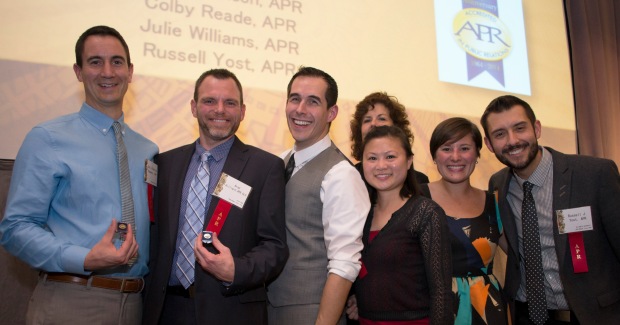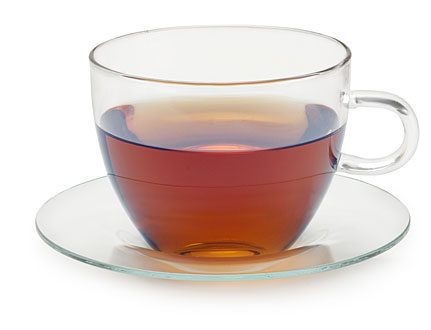
2014 APR recipients Chris Benware, Brad Hilliard, Colby Reade, Tracey Lam, Janet Paulson, me and Russell Yost display an array of styles and personal preferences for “suiting up” on a special occasion.
In my community college small business class recently, one of my classmates who owns a yard maintenance company asked me:
“How do you do it?”
“How do I do what?” I asked with a tilted head and tilted tone.
“Always look so put together and professional. I don’t think I could pull it off like you do.”
How do I do it? I make sure my appearance is clean, cared for (no holes!), fits well, cohesive and appropriate whenever I leave the house.
Lumbersexuals are a perfect example. Notice their clean, pressed jeans, well-shined shoes, flannels with undershirts. Not to mention their coiffure–so meticulous it requires a .50 cent word.
Why should we aspire to “look put together” or “buttoned up” nowadays?
Because Perception is Everything
The Association of Psychological Science published research in 2006 reporting that “all it takes is a tenth of a second to form an impression of a stranger from their face.” I heard recently about other research, which found that appearance is 60 percent of someone’s first impression, followed by tone and then what one actually says or does.
Well, you can’t change your facial structure (nor should you have to), but you can change how you present yourself and your attire.
There is no system for what to wear when. Pairing clothes isn’t like pairing the right wine with food. It’s all about personal preference.
Here are some common questions and concerns.
How Casual is Too Casual
Where I live, the clerks at the grocery store don’t wear uniforms anymore. They wear whatever they want: sometimes it works, sometimes it does not!
Why not? The usual suspects are:
- Be sensitive to body parts – Exposed toes, feet, armpits, and bare backs are usually not welcome, especially in a professional work environment. Unless you’re a masseuse. But, I’ve noticed they take better care of their body parts than I do my cocktail dresses!
- Leave Saturday sweats for Saturday – House: yes, yard: fine, grocery shopping: okay, Opera: NO. Sweat suits were made for sweating and most still communicate that impression. They do not imply clean. As long as you’re comfortable, it’s better to be overdressed than underdressed.
Styling by Season
Once upon a time we had four seasons. I stopped keeping separate seasonal storage containers a couple years ago, mainly because it was silly to have that much stuff, but also because most items can actually be styled appropriately and useful for any time of year.
My closet is now fully co-mingled just like curbside recycling–wool sweaters hanging next to cotton capris!
How to decide what and when?
- Prioritize personal comfort – I run hot, so I wear tank tops all year round and I always bring a sweater, especially for air conditioning. Layering is the perfect solution for managing changing temperatures throughout the day. The key is to layer up, but keep outfits simple.
- Be judicious – People do get colds from wet hair and going out without coats. Be practical about the weather, the building(s), the crowd and the culture, then style it your way.
Suit Up or Not
The looming question: to suit up or not to suit up. Literally wear a suit? YES.
“But, you don’t wear suits?” anyone who knows me would ask. True story. They stifle my self-expression. So, nice dresses are fairly equivalent in my book (hence, the term dressing up?). The goal is to be polished.
Thanks to Barney Stinson of How I Met Your Mother, “suit up” is more than a style, it is a call to action (and popular hashtag).
It says: I have self-respect. I care. I made an effort. This is important.
Some considerations:
- Fair warning, stereotypes persist – a three-piece suit says hipster, two-piece suit says lawyer, investor or traditional executive, ties speak for themselves. Like always, know your audience.
- For better or for worse, you are often taken more seriously when you’re dressed up, including looking older, established or trustworthy. In many situations that is extremely useful.
- Buy used and still look sharp – dressing up doesn’t require big brands or a big budget. Nowadays, it’s easy to feel good about shopping sustainably at second hand stores and still look clean, cared for, fit well, cohesive and appropriate.
At the end of the day, appearance is only the way we look. We can control what we wear when and how we wear it, but not how others see us.
A pleasant, intentional appearance can indeed be a powerful tool and “an act of becoming visible or noticeable.” Use it wisely.
Originally published as Networking Column for PRSA Portland Metro Chapter


 At a recent Willamette University networking event I attended, the speaker brought up the idea of “100 cups of coffee.” The idea was some career counselor’s strategy that before you’re able to take 100 people to coffee you will have landed a job. So I have set the goal to have coffee with 10 people this spring, but not so much to land a job as to learn more about what people do and tips for how they got there. Armed with my little red leather notebook, I went to my on my first “coffee” (some of us don’t drink coffee) with
At a recent Willamette University networking event I attended, the speaker brought up the idea of “100 cups of coffee.” The idea was some career counselor’s strategy that before you’re able to take 100 people to coffee you will have landed a job. So I have set the goal to have coffee with 10 people this spring, but not so much to land a job as to learn more about what people do and tips for how they got there. Armed with my little red leather notebook, I went to my on my first “coffee” (some of us don’t drink coffee) with